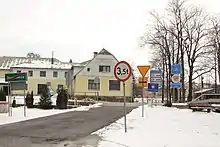Sławniowice
Sławniowice [swavɲɔˈvit͡sɛ] (German: Groß Kunzendorf) is a village in the administrative district of Gmina Głuchołazy, within Nysa County, Opole Voivodeship, in south-western Poland.[1] It is approximately 8 kilometres (5 mi) west of Głuchołazy, 17 km (11 mi) south of Nysa, and 60 km (37 mi) south-west of the regional capital Opole, on the border with the Czech Republic. Until 1742 it and the Czech village of Velké Kunětice were a single settlement; from 1996 to 2007 it was a border crossing point. Its population was 548 in 2011.[2]
Sławniowice | |
|---|---|
Village | |
 Former station | |
 Sławniowice | |
| Coordinates: 50°20′N 17°16′E | |
| Country | |
| Voivodeship | Opole |
| County | Nysa |
| Gmina | Głuchołazy |
| Highest elevation | 310 m (1,020 ft) |
| Lowest elevation | 280 m (920 ft) |
| Population | 548 |

Economy
Marble has been quarried in the village for centuries. Quarrying and shaping marble remains its main industry.
History
Kunzendorf (called Groß Kunzendorf to distinguish it from other places of the same name) is first recorded in 1201 as villa Cunati and in 1382 as Cunczindorff.[3] A Slawnewiz is mentioned in 1291, but its location is uncertain.[4] From the late 13th century the village was within the Duchy of Neisse, an ecclesiastical duchy within the Holy Roman Empire; with the remainder of Upper Silesia, this subsequently became subordinate to the Kingdom of Bohemia. In 1603–15, a peasant revolt took place in the village, one of a series of anti-feudal uprisings against harsh impositions by local landlords under the bishop.[5] In 1742, after the Silesian Wars, what is now Sławniowice became part of the Kingdom of Prussia and was divided from what is now Velké Kunětice, which remained in Austrian Silesia, now in the Czech Republic.[6] It subsequently became part of the German Empire. In 1945, after the defeat of Germany in World War II, it became part of Poland. By an act of the Sejm, it was renamed to Sławniowice in November 1946.[7] A manned border crossing point was established there in February 1996,[8] operating until both Poland and the Czech Republic became part of the Schengen Area in 2007.[6]
In 1845, the village had 6 marble quarries and a population of 531.[3] The population was 908 in 1885,[9] 992 in 1933, and 1,032 in 1939.[10]
Notable people
- Joseph Krautwald, sculptor, trained at the marble works in the village
References
- "Central Statistical Office (GUS) - TERYT (National Register of Territorial Land Apportionment Journal)" (in Polish). 2008-06-01.
- "Ludność – struktura według ekonomicznych grup wieku". Statistics Poland. 2011-03-31.
- Johann G. Knie (1845). Alphabetisch-statistisch-topographische Uebersicht der Dörfer, Flecken, Städte und andern Orte der Königl. preuss. Provinz Schlesien (in German) (2nd ed.). Breslau: Graß, Barth & Co. pp. 336–37. OCLC 17990713.
- Henryk Borek (1988). Górny Śląsk w świetle nazw miejscowych (in Polish). Opole: Instytut Śląski w Opolu. p. 182. OCLC 20091457.
- Berhard W. Scholz (2011). Das geistliche Fürstentum Neisse: eine ländliche Elite unter der Herrschaft des Bischofs (1300–1650) (in German). Cologne / Weimar / Vienna: Böhlau. p. 141. ISBN 9783412213770.
- "Besondere Orte" [Special Locations]. Wochenblatt (in German). 2019-03-27. Retrieved 2023-10-21.
- "M.P. 1946 nr 142 poz. 262: Rozporządzenie Ministrów: Administracji Publicznej i Ziem Odzyskanych z dnia 12 listopada 1946 r. o przywróceniu i ustaleniu urzędowych nazw miejscowości". Internetowy System Aktów Prawnych (in Polish). Sejm.
- "Dz.U. 1996 nr 46 poz. 208: Oświadczenie rządowe z dnia 23 lutego 1996 r. w sprawie wymiany dokumentów ratyfikacyjnych Umowy między Rzecząpospolitą Polską a Republiką Czeską o małym ruchu granicznym, sporządzonej w Pradze dnia 17 stycznia 1995 r." Internetowy System Aktów Prawnych (in Polish). Sejm. 1996-02-23.
- Gemeindelexikon für das Königreich Preußen: auf Grund der Materialien der Volkszählung vom 1. Dezember 1885 und anderer amtlicher Quellen (in German). Vol. 6 Provinz Schlesien. Berlin: Verlag des Königlichen Statistischen Bureaus. 1887. pp. 460–61. OCLC 257483962.
- Michael Rademacher. "Stadt und Landkreis Neisse (poln. Nysa)". Deutsche Verwaltungsgeschichte (in German). Archived from the original on 2009-01-26.
External links
 Media related to Sławniowice at Wikimedia Commons
Media related to Sławniowice at Wikimedia Commons
